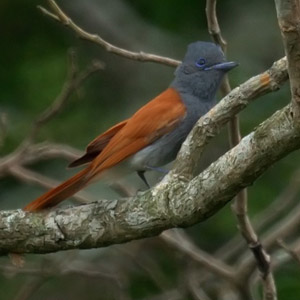Magazine | Voyages
Séjour ornithologique à Oman du 30/11 au 15/12/2000

On peut observer à Oman plusieurs espèces essentiellement africaines, comme le Tchitrec d’Afrique (Terpsiphone viridis).Sourrce : New Jersey Birds / Wikimedia Commons
Introduction
Le sultanat d’Oman se situe au sud de la péninsule arabique. Le littoral de 1700 kilomètres longe le Golfe d’Oman au Nord, la Mer d’Arabie à l’Est et l’Océan Indien au Sud.
La partie nord du pays est dominée par la chaîne du Jebel Akhdar qui atteint 3000 m d’altitude. Son versant au Nord-est borde une plaine fertile, le Batinah, le long du Golfe d’Oman. Au Sud, les montagnes de Dhofar plongent dans l’Océan Indien. En été, la mousson transforme les collines du Sud qui se couvrent alors d’une végétation tropicale.
A l’intérieur du pays s’étend un vaste désert.
Le pays, au croisement de l’Asie et de l’Afrique, accueille des oiseaux nicheurs appartenant aux avifaunes indiennes et africaines. Durant les migrations et en hiver, Oman sert d’étape à de très nombreuses espèces : pas moins de 61 espèces de limicoles et 18 espèces de sternes ont déjà été notées !
Dave Trotter a séjourné dans le pays du 30 novembre au 15 décembre 2000, et il nous a transmis son rapport accompagné de nombreuses photographies.
Abstract
The Sultanate of Oman lies on the north-eastern corner of the Arabian peninsula bordering the United Arab Emirates in the north, the Kingdom of Saudi Arabia in the west and Republic of Yemen in the south-west. The 1700 km coastline faces the Gulf of Oman in the north, the Arabian Sea in the east and the Indian Ocean in the south.
The capital, Muscat, lying on the line of Capricorn is said to be the hottest capital in the world with summer temperatures approaching 50°C in the shade. However, from December through February the weather is 25°C in the daytime, 15°C at night. Usually the sun shines from a clear sky, but the winter months can bring a few quick showers which are much needed and looked forward to.
The northern part of the country is dominated by the mountain range Jebel Akhdar which includes the 3000m. high Jebel Shams. The north-eastern slopes of these mountains form a fertile plain, the Batinah, along the Gulf of Oman.
This is where most of Oman’s estimated 1.5 million people live and where Muscat is located. In the south, the Dhofar Mountains slope towards the Indian Ocean. In summer, the monsoon transforms the hills into extensive grasslands and the mountain valleys take on a tropical look.
The temperature in Salalah, the capital of the southern region, is usually 10-15°C cooler than Muscat at this time of the year. Between the two mountain ranges lies a vast sandy and stony plain which in many places is rather batten and featureless. This is where you experience the real desert. Being some 800 km wide the interior acts as a barrier to many species of birds. Thus the resident birds in the north are similar to those in Asia and India, while Dhofar is much more African in its birdlife.
During migration times and in winter birdwatching can be very exciting. A quick look at a map of this region reveals that eastern Arabia forms a land bridge between Africa and Asia. Masses of birds pass through the country, especially in autumn, and many stay to winter. Particularly interesting is the vast numbers and variety of shore-birds and gulls and terns. No less than 61 species of waders and 18 species of terns have been observed! Raptors are also well represented.
Dave Trotter has visited the country (mostly around Muscat and Salalah) from the 30th of November to the 15th of December 2000, and he has trasmitted us his report, with numerous beautiful photos.
Poursuivez la lecture de cet article, en vous abonnant dès maintenant !
Découvrez les Archives d’Ornithomedia.com
Pour seulement 10,00 €TTC/an (ou 6,00 € les 6 mois)
Profitez de plusieurs centaines d’articles en accès illimité et sans aucun engagement.
Compléments
Auteur
Dave Trotter
Ouvrages recommandés
- Birds of Oman de Michael Gallagher, Martin Woodcock
- Oman & United Arab Emirates Travel Reference Map (Carte) de International Travel
- A Field Guide to the Birds of the Middle East de R. F. Porter et al





Aucun commentaire sur ce sujet
Participer à la discussion !